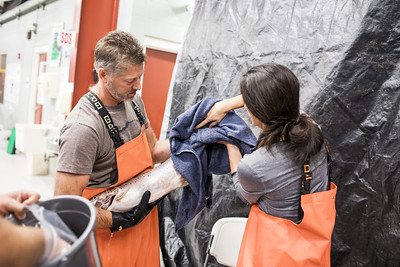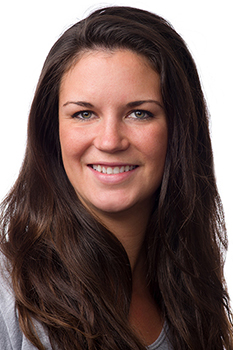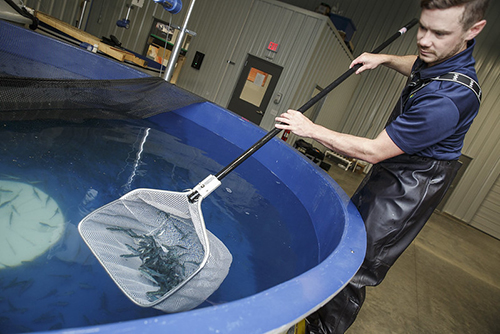Collaborative network for recirculating aquaculture moves into next phase
Over the past three years, Wisconsin Sea Grant has been part of an innovative public/private network that is dedicated to building capacity for the U.S. recirculating aquaculture industry.
Known as RAS-N, the Recirculating Aquaculture Salmon Network involves many partners, from the University of Wisconsin-Stevens Point Northern Aquaculture Demonstration Facility (NADF) in Bayfield, to the Maine and Maryland Sea Grant programs, to private companies in the United States and Europe, including Hixton, Wisconsin-based Superior Fresh.
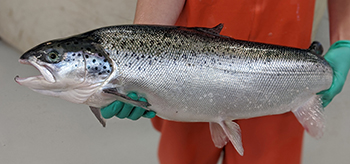
This Atlantic salmon has been raised in water reuse systems at the University of Wisconsin-Stevens Point Northern Aquaculture Demonstration Facility in Bayfield. (Photo: NADF)
Recirculating aquaculture systems (RAS) are a water-efficient way of raising fish on land in a contained system; other positive attributes of this farming method include enhanced biosecurity and the ability to reduce the carbon footprint of food fish by building facilities close to markets.
The National Sea Grant Office announced funding for RAS-N in 2019. While that three-year grant is now winding down, the collaborative network it helped build is not going away. Rather, it is entering an exciting new phase with $10 million in funding from a U.S. Department Agriculture (USDA) program designed to enhance sustainability in agriculture.
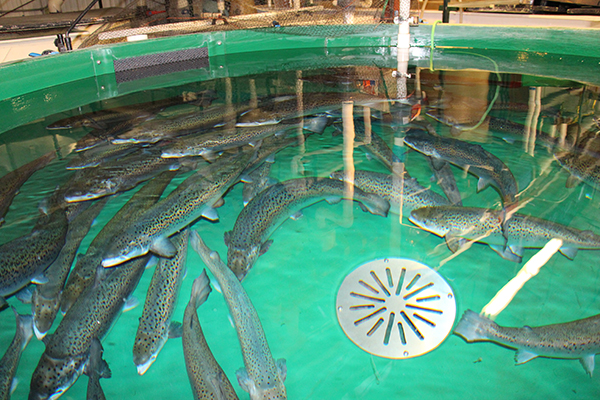
Land-based water reuse systems, like the tanks shown here, can provide an optimal, carefully controlled environment for Atlantic salmon to thrive. (Photo: NADF)
The USDA support was awarded to the University of Maine Aquaculture Research Institute in collaboration with the University of Maryland Baltimore County. Wisconsin Sea Grant and NADF remain closely involved in this new phase of the work, dubbed SAS² (for Sustainable Aquaculture Systems Supporting Atlantic Salmon).
Specifically, NADF will investigate out-of-season spawning of Atlantic salmon to develop procedures that can be used by industry to produce eggs year-round.
Additionally, NADF staff, working with other aquaculture educators, will contribute their expertise in merging sustainable RAS science, community engagement and workforce development for the RAS industry.
This large vision encompasses a multitude of objectives involving technology transfer, incorporating RAS education at the high school and college levels and expanding NADF’s current internship program. SAS² will also work to increase public awareness of this growing industry.
Said Dr. Chris Hartleb, NADF director and a professor of fisheries biology at the University of Wisconsin-Stevens Point, “Through our facility, Wisconsin has been a key collaborator on the RAS-N project with expertise in RAS and salmon culture. As a further expansion of that project, SAS² continues Wisconsin’s pivotal role in the development and growth of Midwest recirculating aquaculture of the valuable and tasty Atlantic salmon.”
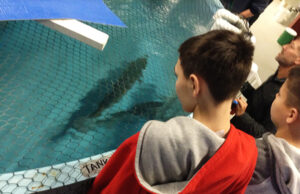
Tours of the Northern Aquaculture Demonstration Facility educate the public about sustainable aquaculture. (Photo: NADF)
Indeed, Atlantic salmon remains one of the most popular choices for American seafood consumers, yet 96% of the salmon consumed here is imported, reflecting a dramatic trade deficit. By addressing bottlenecks and barriers affecting the growing salmon RAS industry, RAS-N and now SAS² are working to make the industry both economically feasible and environmentally sustainable.
To learn more about the RAS-N and SAS² networks, visit ras-n.org.
You can also read more about this work on the websites of the NADF, the University of Maryland Baltimore County and the University of Maine.
The post Collaborative network for recirculating aquaculture moves into next phase first appeared on Wisconsin Sea Grant.News Releases | Wisconsin Sea Grant
News Releases | Wisconsin Sea Grant
https://www.seagrant.wisc.edu/news/collaborative-network-for-recirculating-aquaculture-moves-into-next-phase/?utm_source=rss&utm_medium=rss&utm_campaign=collaborative-network-for-recirculating-aquaculture-moves-into-next-phase

